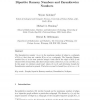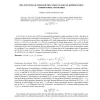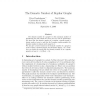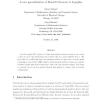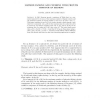97
Voted
DM
2000
15 years 5 days ago
2000
The Zarankiewicz number z(s, m) is the maximum number of edges in a subgraph of K(s, s) that does not contain K(m, m) as a subgraph. The bipartite Ramsey number b(m, n) is the lea...
75
Voted
DM
2000
15 years 5 days ago
2000
Let exq(G; n) be the maximum number of points in a rank-n geometry (simple matroid) that is representable over GF(q) and that has no restriction isomorphic to the geometry G. We fi...
81
Voted
COMBINATORICA
2004
15 years 6 days ago
2004
Consider a k-element subset P of the plane. It is known that the maximum number of sets similar to P that can be found among n points in the plane is (n2 ) if and only if the cros...
94
Voted
ARSCOM
2004
15 years 7 days ago
2004
The domatic number of a graph G is the maximum number of dominating sets into which the vertex set of G can be partitioned. We show that the domatic number of a random r-regular g...
JCT
2007
15 years 8 days ago
2007
Let the k-graph Fank consist of k edges that pairwise intersect exactly in one vertex x, plus one more edge intersecting each of these edges in a vertex different from x. We prov...
85
Voted
SIAMDM
2008
15 years 9 days ago
2008
The first-fit chromatic number of a graph is the number of colors needed in the worst case of a greedy coloring. It is also called the Grundy number, which is defined to be the max...
106
Voted
GC
2007
Springer
15 years 9 days ago
2007
Springer
A clique is a set of pairwise adjacent vertices in a graph. We determine the maximum number of cliques in a graph for the following graph classes: (1) graphs with n vertices and m ...
87
Voted
JGT
2006
15 years 10 days ago
2006
We find the maximum number of maximal independent sets in two families of graphs. The first family consists of all graphs with n vertices and at most r cycles. The second family i...
88
Voted
DM
2007
15 years 10 days ago
2007
We consider the problem of determining the maximum number of moves required to sort a permutation of [n] using cut-and-paste operations, in which a segment is cut out and then pas...
JCT
2006
15 years 10 days ago
2006
Abstract. In 1981, Seymour proved a conjecture of Welsh that, in a connected matroid M, the sum of the maximum number of disjoint circuits and
